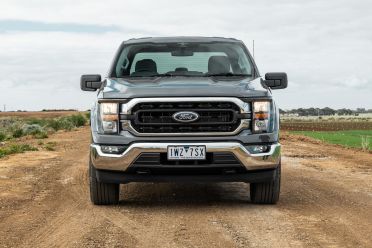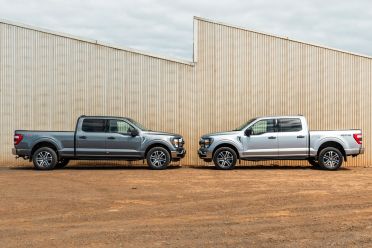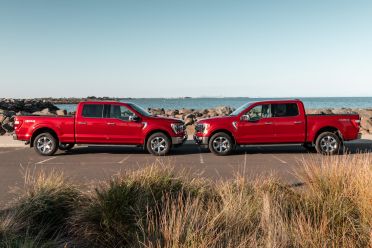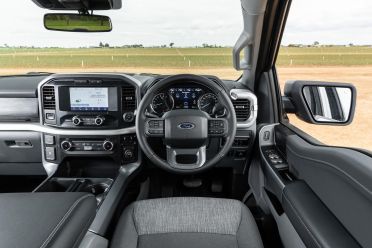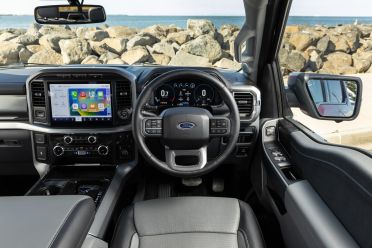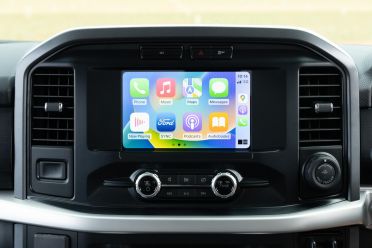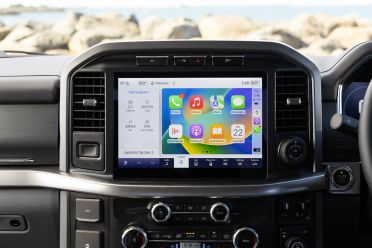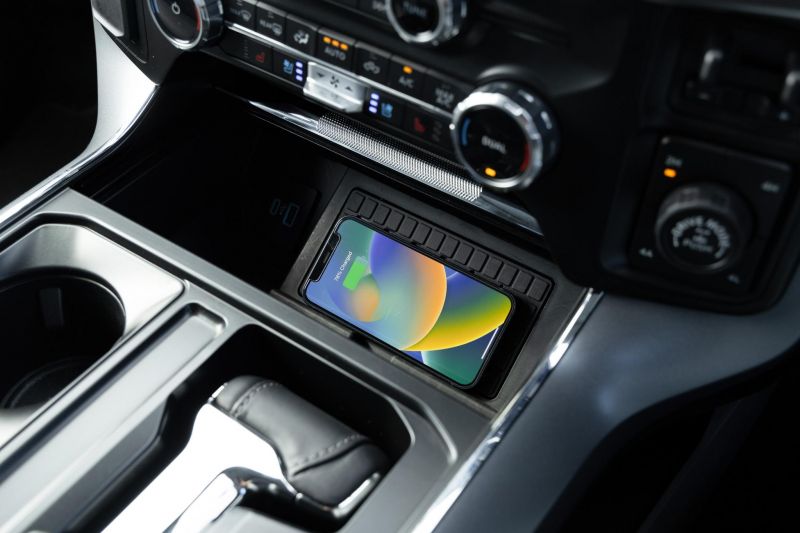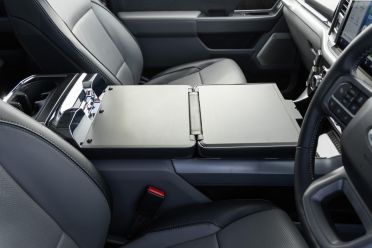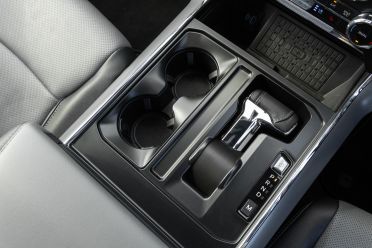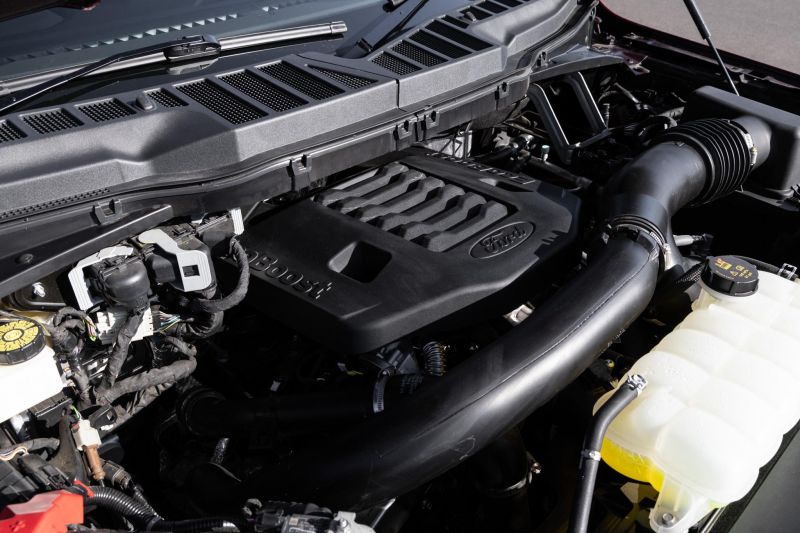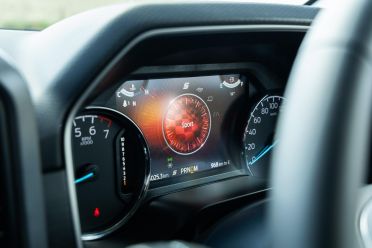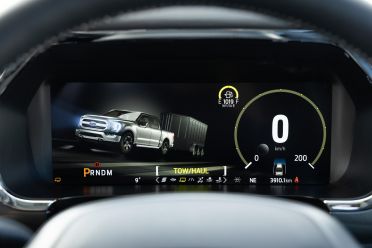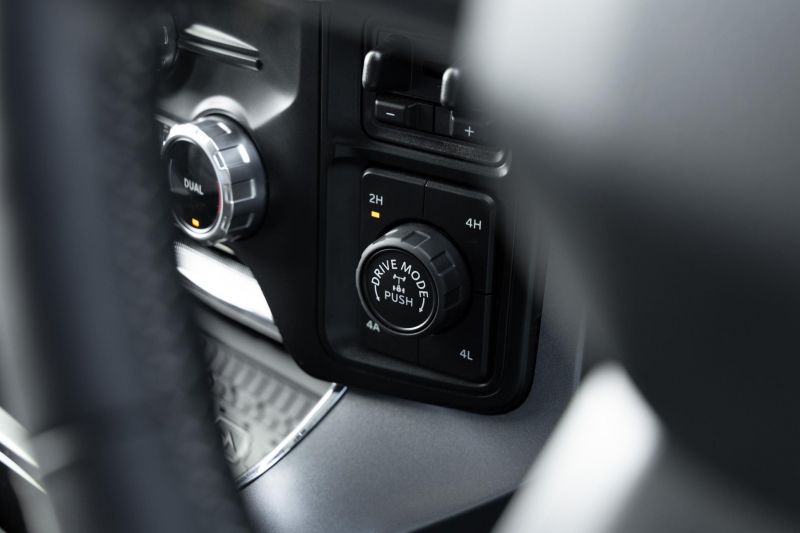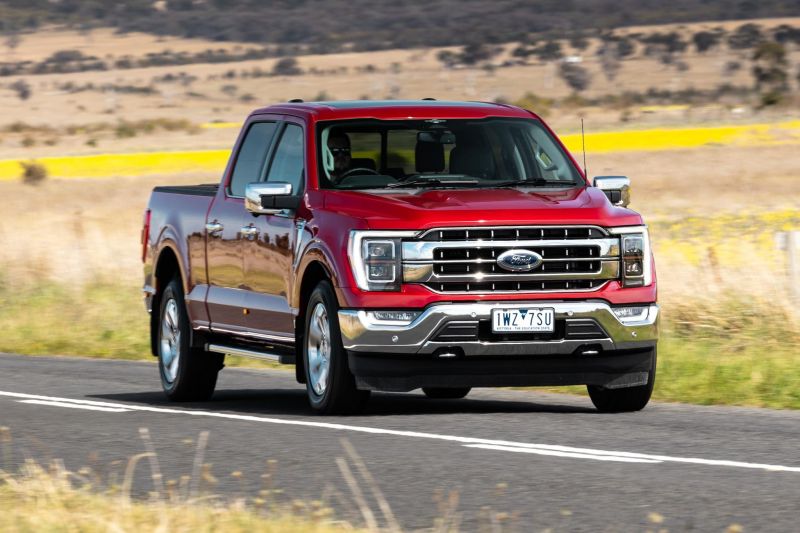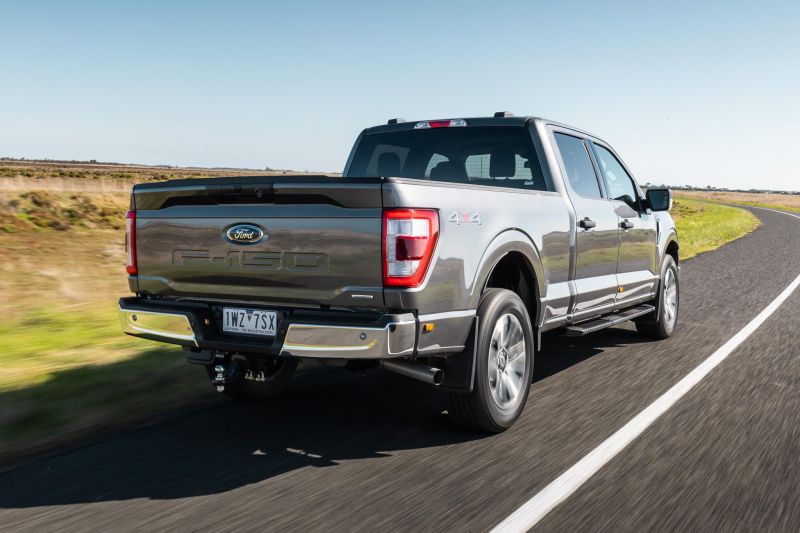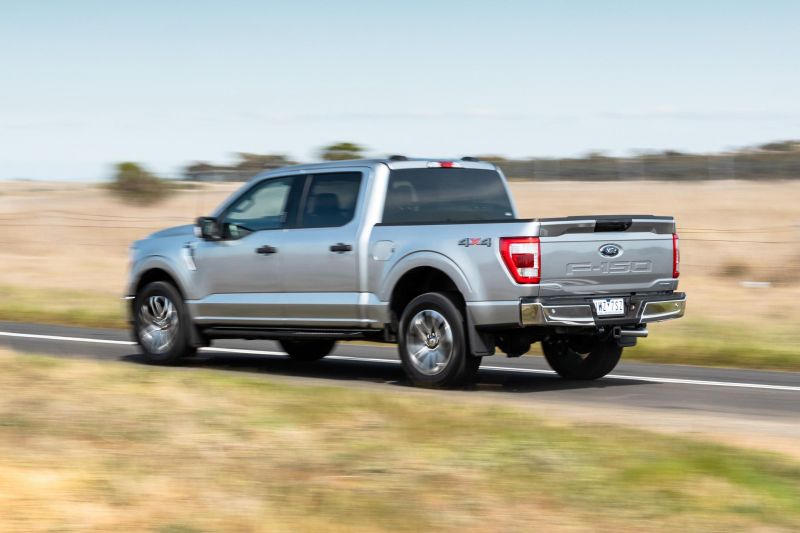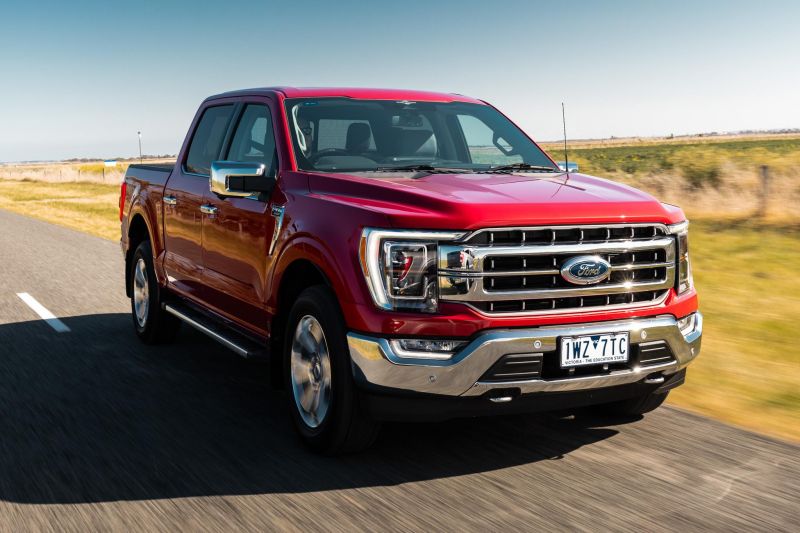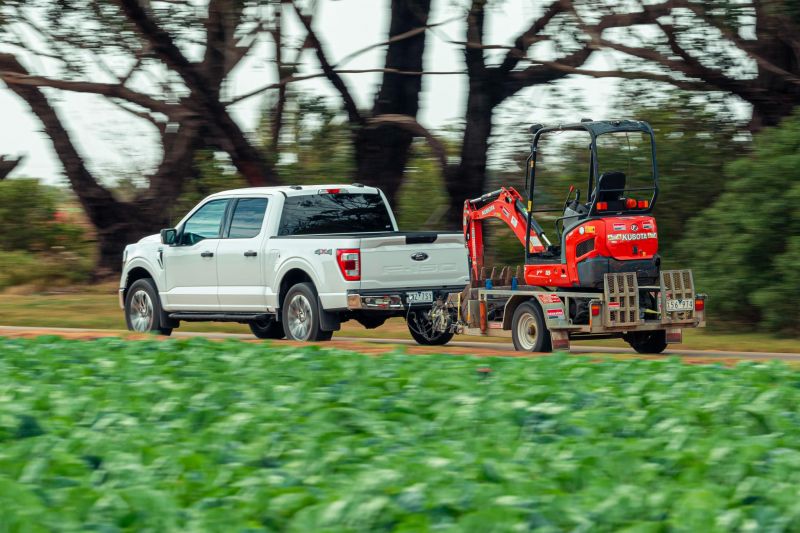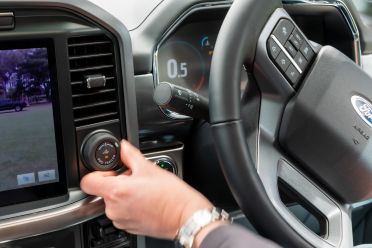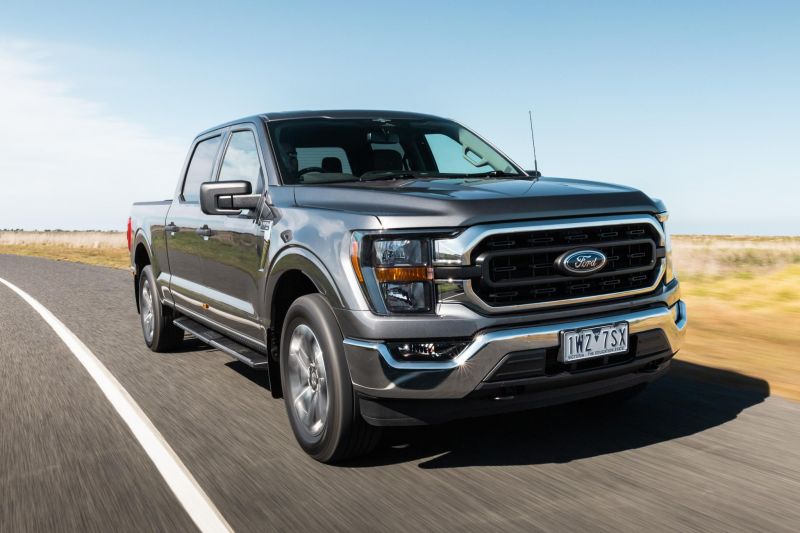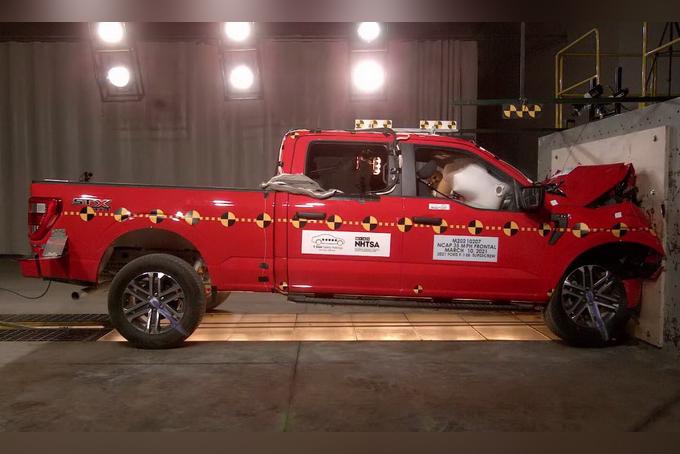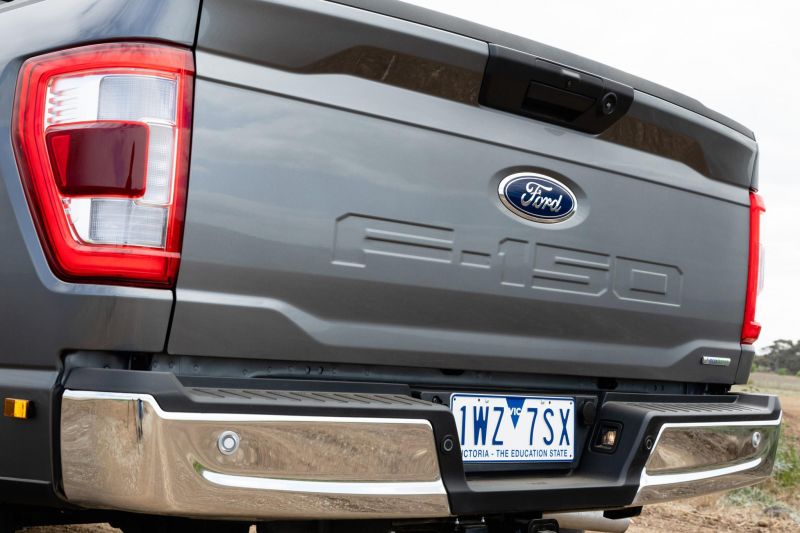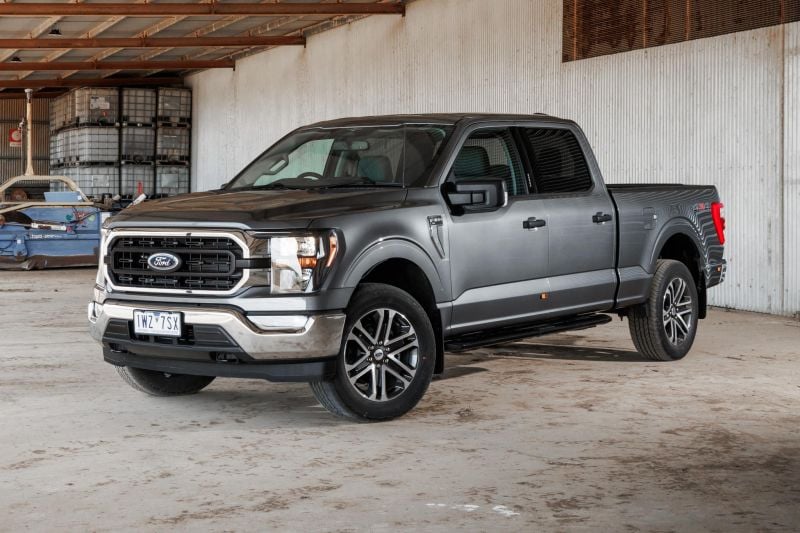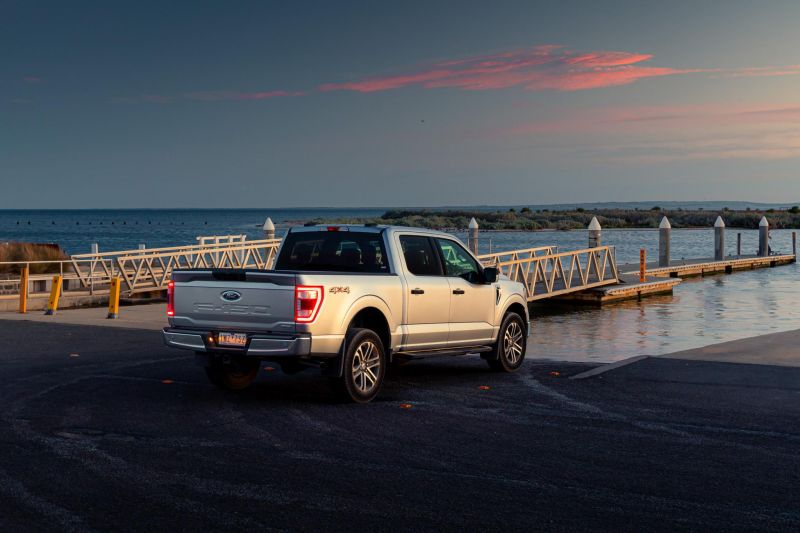The Ford F-150 is arriving a little later than its rivals to the Australian new car market, though it’s just about here with customer deliveries set to commence in November.
Unlike its Ram 1500 and Chevrolet Silverado 1500 rivals, the Ford F-150 is remanufactured locally from left- to right-hand drive by RMA Automotive at a facility in Mickleham, Victoria.
The 21,000 square-metre facility is currently in its ramp-up phase and once it’s fully operational it will be able to remanufacture up to 20 F-150s per day from left- to right-hand drive.
Each vehicle currently takes around 22 hours over three working days to remanufacture from left- to right-hand drive.
As part of the remanufacturing process, around 500 parts are installed or modified on the F-150. To read a full breakdown on what is an isn’t changed in the remanufacturing process, click here.
Full-size pickup sales are on the rise in Australia, though how does the Ford F-150 stack up against its growing number of rivals? Read along to find out.
How much does the Ford F-150 cost?
The local Ford F-150 range is available at launch in two different trim levels with two wheelbase lengths.
In terms of competitors, there are the Chevrolet Silverado 1500 ($128,000–$133,000) and the Ram 1500 ($98,950–$224,950). Although Toyota hasn’t confirmed official Australian launch timing for the Tundra, it’s currently in the final validation stage of the right-hand drive program.
Ford Australia says 65 per cent of F-150 buyers are opting for the flagship Lariat trim level, with the other 35 per cent going for the entry-level XLT variant. It says the majority of the latter are from regional markets.
The company also says over 40 per cent of F-150 buyers are opting for the short-wheelbase body style. That means the majority of F-150 buyers are going for the long-wheelbase body style.
Ford Australia is aware of the F-150 Hybrid, Raptor, V8, and electric Lightning options available in other markets. It hasn’t ruled out bringing them Down Under, but only once the remanufacturing process is established and demand for the EcoBoost has been proven.
2024 Ford F-150 pricing:
- Ford F-150 XLT SWB: $106,950
- Ford F-150 XLT LWB: $107,945
- Ford F-150 Lariat SWB: $139,950
- Ford F-150 Lariat LWB: $140,945
Prices are before on-road costs
What is the Ford F-150 like on the inside?
Walking up to the Ford F-150 it’s immediately obvious that it has some serious presence. The thing is huge! You can also tell where the smaller Ranger ute gets some of its exterior design cues.
The flagship F-150 Lariat has Zone Lighting which is a feature shared with certain Ranger variants. It lights up the perimeter of the pick-up which is a feature that comes in handy when you’ve parked in pitch black darkness.
Hopping up and into the F-150 is a bit of feat in itself as it’s a fair climb. You have to actually use the side steps and the grab handles in order to get in.
As standard the entire local F-150 range has a 12-way electric driver’s seat. For the XLT this is an upgrade compared to the US-spec model which only gets manually adjustable seats as standard.
The driver’s seat electric adjustment allows drivers of almost any shape and size in sit comfortably. I enjoyed how much thigh adjustment the F-150’s driver seat offers as it allows you to get scooped up into the seat.
In addition to the driver’s seat offering a large degree of electric adjustment, the entire F-150 range offers electrically adjustable pedals. Although this didn’t really worry me at a leggy 182cm, I can see this feature being of great use for shorter people.
The F-150 XLT comes with cloth upholstery as standard that feels absolutely delicious to the touch and doesn’t get too hot. The F-150 Lariat on the other hand has leather upholstery with heated and ventilated front seats. The latter’s ventilation function was used quite thoroughly on the local media launch drive day and I can attest that it works quite well.
Ahead of the driver is a large leather-wrapped steering wheel that feels nice in the hand and has a large number of physical buttons with a clicky feedback.
Depending on the variant, there’s a different gauge cluster setup. The XLT receives a set of really clear analogue dials for the revs and speed with a smaller 8.0-inch digital instrument cluster sandwiched between them.
The Lariat on the other hand has a proper 12.0-inch digital instrument cluster offers really high resolution and has almost limitless configurability options. There’s a clear connection with how the Ranger’s full-digital instrument cluster looks in higher grades.
Regardless of which variant you pick, there are really cool animations that flash up when you change the drive mode. It’s quite fun to flick through just to see the animations, though I recommend doing this while stationary as you’ll want to focus your entire attention on them.
Moving across, the central touchscreen infotainment differs depending on which F-150 variant you opt for. The XLT receives a smaller 8.0-inch touchscreen infotainment system, whereas the Lariat gets a larger 12.0-inch touchscreen.
The former’s 8.0-inch unit looks rather puny on the expansive dashboard and is notable lower resolution than the latter’s 12.0-inch unit. Both touchscreens however load up really quickly upon start up and are super responsive to touch inputs.
Ford has gone to town with the Australian-spec F-150, giving it a local version of the SYNC4 infotainment system with right-hand drive graphics. There’s also an Australian DAB+ digital radio tuner, and a locally compatible modem for FordPass connected services.
Wireless Apple CarPlay and Android Auto comes as standard on the entire F-150 range. It’s very easy to connect up with the voice prompts on the infotainment system assisting you. It also connects very quickly upon start up and I didn’t experience any drop outs whatsoever with my iPhone 12 Pro Max.
Something to note is the F-150 XLT misses out on a wireless phone charger, though it is standard on the F-150 Lariat. You’ll need to be mindful with this as you might need to plug your phone in with a USB cable if don’t want your phone’s battery to drain with wireless smartphone mirroring.
Satellite navigation is also standard across the entire F-150 range, which regardless of the screen size is very natural and simplistic to use.
There are soft-touch finishes in the majority of the high touch-point areas around the cabin, including the armrests and dashboard, though harder plastics are elsewhere and not hard to find.
I know I already emphasised how big the F-150 is on the outside, but I can’t stress just how much space there is inside the cabin. This is made even more apparent in the Lariat when you have the panoramic sunroof’s shade open.
In terms of first-row storage space there are upper and lower glove boxes, huge door pockets, as well as an absolutely massive centre console.
Speaking of the centre console, the lid is able to fold out to create a small desk that, for example, can used for a place to sit your laptop or to eat your lunch at.
In order to make this function work in the F-150 Lariat with its centre-console-mounted e-Shifter, there’s a button you can press which folds it down flat. RMA Automotive retooled 30 internal components of this e-Shifter in order to make it work for right-hand drive.
This isn’t something that wasn’t a worry with the F-150 XLT, as it has a column-mounted gear selector instead.
The F-150 XLT has a seven-speaker sound system as standard, which sounds completely fine, though the F-150 Lariat receives a stonking 18-speaker Band & Olufsen premium sound system that’s fantastic. The latter’s sound system even received a unique right-hand drive tune.
Moving to the second row of the F-150, you’ll be blown away yet again at how much space there is. It’s palatial and there’s almost too much space as you feel so far away from the front row.
Legroom is absolutely fantastic, as well as head- and shoulder-room, though I found toe room was lacking a tad. I also found my legs where up pretty high.
There isn’t a noticeable downgrade in terms of quality in the second row, with the three-person bench seat really squishy and comfortable. There are also plenty of grab handles to help with ingress and egress, plus the seat base is also able fold up with a 60:40 split.
In terms of second-row amenities, the F-150 comes with centre-console-mounted air vents, a 12V socket, and two USB ports. The Lariat adds outboard heated seats, a power sliding rear window, as well as a fold-down centre armrest with cupholders.
Moving to the tub, there are two different lengths available. The tub on the F-150 SWB is 1705mm long, 1656mm wide (1285mm between the arches), and 543mm tall. The F-150 LWB’s tub is 300mm longer at 2005mm.
The tailgate on the F-150 Lariat has an electric opening and closing functionality, which is incredibly nifty. The F-150 XLT’s regular tailgate on the other hand is still really light to lower down and close back up.
A tubliner comes as standard across the entire local F-150 range, as well as a range of tie-down points. There’s also an integrated step that pulls out of the tailgate, as well as a pull-out handle.
You need to step up to the Lariat in order to get a 12V socket in the tub, as well as lights that can be activated with a push of a button.
What’s under the bonnet?
The entire 2024 Ford F-150 range is powered by a 3.5-litre ‘EcoBoost’ twin-turbo V6 petrol engine producing 298kW of power and 678Nm of torque.
In the US the F-150 is available with a 3.3-litre V6 petrol engine, which is set to be dropped with the recently revealed facelift. Other engine options include a 2.7-litre EcoBoost twin-turbo V6, 3.5-litre EcoBoost Hybrid, 3.5-litre High Output twin-turbo V6 in the Raptor, and a 5.2-litre supercharged V8 in the Raptor R.
All Australian-specification F-150 models have a 10-speed automatic transmission with drive sent through a four-wheel drive system. There’s also an electronic locking rear differential.
The XLT variants have a part-time four-wheel drive system with 2H, 4H, and 4L modes, whereas the Lariat variants have a full-time four-wheel drive system with 4A mode.
This V6 EcoBoost petrol engine uses a pair of injectors per cylinder along with twin-intercooled turbochargers claimed to minimise lag.
Both F-150 variants come with the following drive modes:
- Normal
- Sport
- Eco
- Tow/Haul
- Slippery
- Deep Snow/Sand
- Mud Ruts
Claimed fuel consumption for the entire Ford F-150 range is 12.5 litres per 100km. During the local media launch which consisted of driving a number of different F-150s configurations completely unladen on the outskirts of Melbourne, the average fuel consumption was pretty much line ball with the estimate.
This fuel economy figure is notably better than some of the F-150 rivals which stick with naturally-aspirated V8 petrol engines.
All local F-150 models get a 136-litre long-range fuel tank as standard and require a minimum of 91 RON unleaded petrol.
The entire Ford F-150 range comes standard with a 4.5-tonne rated tow bar with a 70mm ball, however a 3.5-tonne tow hitch with a 50mm ball is available as an option. An integrated trailer brake controller comes as standard.
Payload varies from 685kg to 794kg, depending on the variant, which is down compared to smaller utes like the Ranger though similar to other full-size pickups.
How does the Ford F-150 drive?
Starting up the F-150 you instinctively expect to hear the rumbling of V8 under the bonnet, but instead you get the smooth startup and refined idle of a V6. It’s not as offensive to the ear as you’d initially think.
The 3.5-litre EcoBoost twin-turbo V6 petrol engine provides an effortless surge of power and torque from standstill with its 298kW and 678Nm outputs. It’s definitely more than enough to get this circa-2.5-tonne pickup moving.
You’ll be able to keep up traffic with no worries whatsoever, and with more liberal application of the throttle you’ll easily pull ahead of the traffic. If you do this you’ll get to hear the surprisingly lovely feedback of the petrol V6.
Something all the journalists noticed throughout the local media launch drive program was the flagship F-150 Lariat sounded notably better than the XLT.
Initially we thought the Lariat might have some form of bi-modal exhaust, though Ford confirmed it’s because it has a better sound system. Yes, you read that correctly, there’s fake engine noise plumbed into the cabin.
If you really give the F-150 the berries, or need to get moving quickly, peak torque doesn’t come on tap until 3100rpm. This is higher than smaller diesel-powered utes, though the F-150’s rivals are only available locally with petrol engines.
The 10-speed automatic transmission is able to keep revs effortlessly in the engine’s torque band, as there are so many gears to select from. It’s largely slick in terms of its operation, though you can catch the transmission napping if you punch it, which causes the transmission to jump down a considerable amount of ratios.
Certain variants of the F-150 are lighter and quicker to sprint to 100km/h than the Ranger Raptor, which is a handy to fact to know. This is due in part to the F-150’s lighter aluminium body-on-frame platform.
The F-150 comes with a four-wheel drive system as standard, though there are two different applications depending on which variant you opt for.
The F-150 XLT comes with a part-time four-wheel drive system with an electronic shift-on-the-fly function. This system doesn’t allow for the pickup to be in four-wheel drive when on sealed surfaces, meaning it’s only rear-wheel drive in normal driving. 4H and 4L can still be activated on unsealed surfaces.
The F-150 Lariat has a more sophisticated full-time four-wheel drive system, which allows the pickup to be in four-wheel drive on sealed surfaces. This can come in handy in certain situations, including when you’re driving in rainy or slippery roads.
There were also certain points where the F-150 XLT’s rear wheels lost traction when taking off, which this is something that’s negated with the F-150 Lariat’s full-time four-wheel drive system.
In and around urban areas, the F-150 it feels super large and a little out of place. You sit up very high in the F-150 and although there’s plenty of glass, there are still a number of blind spots.
The steering system in the locally remanufactured F-150 uses a modified Ranger Raptor steering rack, as well as a new intermediate shaft assembly and recalibrated steering software.
Twirling the steering wheel at low speeds is easy enough, though there’s no way to escape how large the F-150’s turning circle is. Be prepared to be doing three-, four-, or even five-point turns depending on how tight the street is.
This can be a little frustrating with the F-150 XLT’s column-mounted gear shifter, though you quickly get used to it.
That brings me to parking the F-150, which isn’t the easiest thing to do. This is even worse with long-wheelbase versions that measure almost 6.2 metres long. For context, the standard parking space in Australia measures in at 2.4 metres wide and 5.4 metres long.
The F-150 doesn’t come with an Australian-specific suspension tune, which is really compliant at low speeds. It glides over speed bumps, though it does the get a bit of a rock up in certain situations.
Building up the speed in the F-150 is really easy and you’ll notice the pickup does take up the majority of the lane when driving. It feels rock solid, with even the harshest of crosswinds not making the F-150 bat an eyelid.
Once you’re at highway speeds the F-150 finds its groove and becomes arguably one of the best highway cruisers on sale. You feel like the king of the road.
The ride is largely compliant, with the pickup reacting to large singular bumps quite naturally, though if there are continuous bumps the F-150 does feel floaty and a little ungainly. This is one of the few instances a local suspension tune would be helpful.
Due to the F-150’s size, you need to be very careful when you go to overtake that there isn’t a car in your blind spot as the mirrors have a funky shape. Thankfully, blind-spot monitoring comes as standard and can be programmed to take the length of a trailer into account.
Speaking of trailers, I got the opportunity to tow an excavator on a trailer which weighed around 2.7 tonnes. The F-150 handled this trailer effortlessly. It accelerated and handled as if there was nothing attached at all.
The only telling sign there was a trailer attached to the F-150 was under braking. This particular trailer was equipped with hydraulic brakes, which sometimes sent a jolt through the pickup when you go to accelerate and the brakes are still disengaging.
The entire F-150 range comes with the Ford Pro Trailer Back-Up Assist system that’s an ingenious way to reduce the amount of complexity when reversing a trailer. Specifically, it takes away the need to think about turning the steering wheel the opposite direction to steer the trailer in the intended direction.
In order to make this function work, you need to equip a yaw sensor to the trailer you want to reverse with a special round connector on the F-150. You then program the trailer’s parameters in the F-150’s infotainment system.
Once it’s all connected you need to calibrate the sensor on the trailer by driving around on a flat surface. After this point you can properly use the system.
Reversing a trailer with the Ford Pro Trailer Back-Up Assist is trippy to begin with as you technically steer the trailer instead of the pickup with a small knob to the left of the steering wheel. It takes a bit of practice to master, though once it makes sense it’s quite natural.
Something to note is this trailer reversing system requires you to use the infotainment system and the reversing camera. This is a little harder when the XLT’s 8.0-inch infotainment screen is smaller and lower resolution than the Lariat’s 12.0-inch unit.
On the safety front, the entire Ford F-150 is well equipped with the essentials. The XLT does come with a wide array of active safety equipment, though the Lariat adds technology such as intersection assist, lane centring, and evasive steering assist.
You also need to step up to the F-150 Lariat to get adaptive cruise control with stop/go, a surround-view camera, and front parking sensors. These are things that should really be standard across the range given the F-150 starts at over $100,000.
All the safety systems in the F-150 range work completely fine, though it’s unfortunate you need to spend over $140,000 to get the full suite of equipment.
What do you get?
F-150 XLT highlights:
- 20-inch machined faced alloy wheels
- 18-inch alloy spare wheel
- Automatic LED headlights
- LED tail lights
- Two-bar style grille with chrome surround and black accents
- Chrome front and rear bumpers
- Black side mirrors and door handles
- Heated side mirrors
- Black platform side steps
- Passenger side keypad entry
- Tailgate with flexible step and work surface
- Spray-in bedliner
- Boxlink cargo management locking cleats
- Underbody skidplates
- 8.0-inch digital instrument cluster
- 8.0-inch SYNC4 touchscreen infotainment system
- Satellite navigation
- 7-speaker sound system
- FordPass connect
- Dual-zone climate control
- Fold-out office workspace
- Column-mounted gear selector
- Cloth upholstery
- 12-way power-adjustable driver’s seat
- 10-way power-adjustable front passenger’s seat
- Power-adjustable foot pedals
F-150 Lariat adds:
- Premium mesh insert grille with chrome surround
- Chrome mirror scalps, door handles, belt mouldings, tow hooks, and side steps
- Automatic high-beam
- LED front fog lights
- Zone Lighting
- Load box illumination
- Powered twin-panel moonroof
- Power release and close tailgate
- Power sliding rear window
- 12V socket in bedliner
- 12.0-inch digital instrument cluster
- 12.0-inch touchscreen infotainment system
- 18-speaker Bang & Olufsen sound system
- Wireless phone charger
- Console-mounted gear shifter
- Interior ambient lighting
- Leather-accented upholstery
- Heated and cooled front seats
- Heated rear outboard rear seats
- Driver seat memory
- 12-way power-adjustable front seats
- Power-adjustable foot pedals with memory
- Rear centre armrest with cupholders
- Remote start
- Adaptive cruise control with stop/go
- Lane centring
- Evasive steering assist
- Speed sign recognition
- Surround-view camera
- Front parking sensors
Is the Ford F-150 safe?
The Ford F-150 hasn’t been assessed by Australian safety authority ANCAP yet, so for now it remains unrated.
In the US the F-150 was awarded a five-star safety rating according to testing conducted by the National Highway Traffic Safety Administration (NHTSA).
Standard safety features include:
- 6 airbags
- Autonomous emergency braking (AEB)
- Blind-spot monitoring with trailer tow coverage
- Rear cross-traffic alert
- Lane-keep assist
- Driver alert system
- Cruise control
- Reversing camera
- Rear parking sensors
- Ford Pro Trailer Back-Up Assist
F-150 Lariat adds:
- Intersection assist
- Lane centring
- Evasive steering assist
- Adaptive cruise control with stop/go
- Speed sign recognition
- Surround-view camera
- Front parking sensors
How much does the Ford F-150 cost to run?
The locally remanufactured Ford F-150 is backed by a five-year, unlimited-kilometre warranty like the rest of the Ford Australia line-up.
Logbook servicing is required every 12 months or 15,000km, whichever comes first. Ford Australia hasn’t detailed how much each service costs at this stage.
CarExpert’s Take on the Ford F-150
The Ford F-150 is a big ute and there’s no escaping that fact. It’s set to splash onto the Australian new car market a little later than its rivals, though it’s just as sales in full-size pickups are on the rise.
It has a properly spacious interior, and depending on the specification the F-150 can be very luxurious. Just be prepared to dig deeper into your wallet if you want the extra bells and whistles.
Although the F-150’s V6 engine lacks the displacement of its V8-powered rivals, it offers enough punch to make you not think about the missing two cylinders. It also tows very effortlessly.
It’s unfortunate Ford has reserved some of the F-150’s safety technologies for the flagship Lariat variant as safety shouldn’t be a compromise – especially in a car that costs over $100,000 in its most basic guise.
Ford and RMA Automotive have put an obvious amount of time, effort and thought into the remanufacturing process for the Australian-specification F-150. The vehicles we drove at the local media launch drive felt very well put together, though it’s going to be interesting to see how they stand the test of time.
Click the images for the full gallery
BUY: Ford F-150
MORE: Everything Ford F-150

